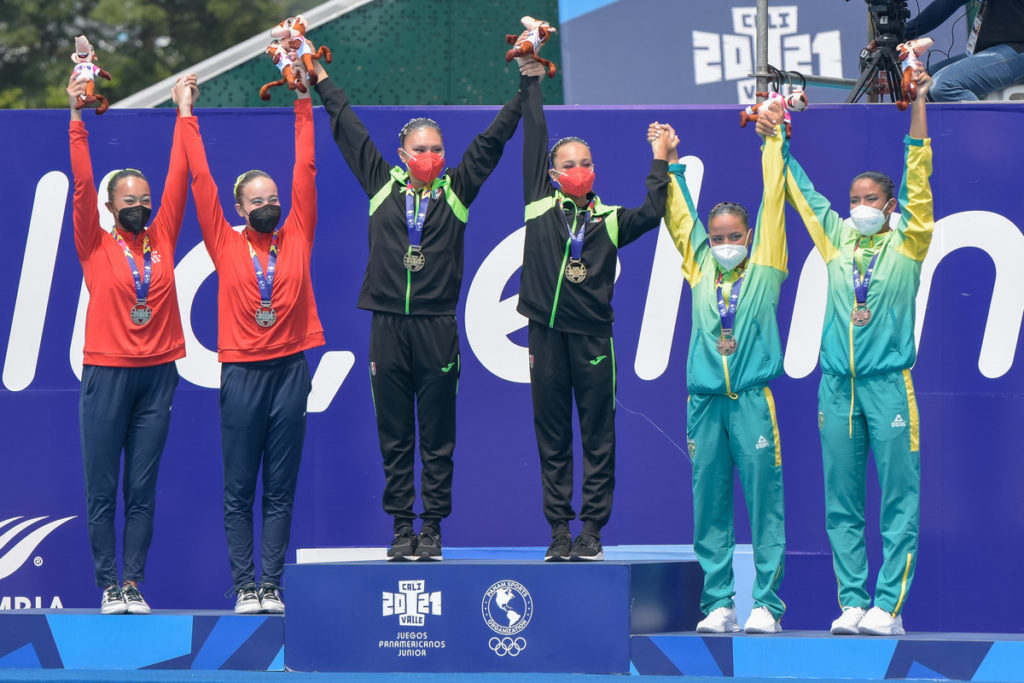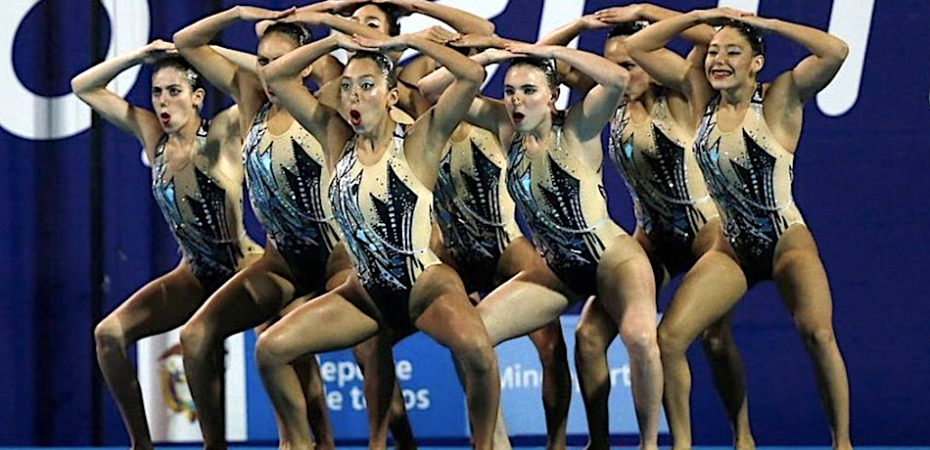15 countries participated in the inaugural Junior Pan American Games hosted by Cali, Colombia. Mixed duets and highlights were included on the programme for the first time in a meet related to the Olympic movement.
Mexico and the U.S. topped the standings, winning medals in all four events. The Mexican team was particularly dominant throughout, and comfortably earned three golds (duet, team, highlight) and a silver (mixed duet). The U.S. won the mixed duet title, and silver in the other three events. Brazil and Colombia grabbed two bronze medals each.
These juniors squads had already faced off a few times during the 2021 season. Mexico, the U.S., Colombia and Chile competed in-person in August at the Junior & Youth International Open (JYIO). Argentina, Brazil and Peru also participated virtually. Additionally, Mexico and most of the South American nations had met up in May for the UANA Pan American Championships (UANAs).
Before this year, Mexico hadn’t competed as a team across all age groups since 2019. The senior squad faced difficulties during the Covid-19 pandemic, and withdrew from contending to a team spot at the Olympic Games Qualification Tournament in 2021.
The juniors faced similar difficulties and multiple cancellations and postponements, including the 2020 FINA World Junior Championships that was pushed twice. In the end, they had not really competed in a major international meet since 2018.
Led by Ofelia Pedrero, also the assistant coach of the senior team, this junior squad displayed a promising future. It showed excellent, sharp, precise and well-choreographed and entertaining routines that propelled them to the top of the podium three times.
Right from the start, the duet of Itzamary Gonzalez Cuellar and Fernanda Arellano set the tone in the technical event. They swam to Jerry Lee Lewis’ “Boogie Woogie Country Girl,” and separated themselves from the pack by nearly three points after posting a 81.1175.
It had been a close one last time the pair faced the U.S. at the JYIO. There, Megumi Field and Anya Melson had finished ahead by 0.2581. This time, the Mexicans ran away with it.
Their flamenco free routine was again a step above the competition, with great difficulty and sharp execution. They took the lead in the event with another three-point edge, and were simply impossible to catch.
In the team event, a close battle was anticipated between Mexico and the U.S. Back at the JYIO, the Mexicans had finished ahead of the U.S. in technical team by 0.0018 points. The Americans did not swim in free back then, so it was difficult to predict a favorite for first here.
Both nations showed previous senior team routines, and the plot repeated itself in Cali. After the technical event, Mexico had again a very small lead of 0.093 points over the U.S. with its routine set to a remix of “Straight to Memphis” from Club des Belugas.
In the free event, the squad used the “Space” routine that only ever really got performed three times by the seniors in 2019. The juniors showcased incredible, high-flying acrobatics, and their dynamic and clean swim received 83.5667. It was ultimately enough to give them the win in combined score by a little over a point over the U.S.
Finally, the Mexicans closed out the competition with a powerful performance in highlight, where they dominated the competition with 82.8000. Their impressive acrobatics and strong swim in a routine centering around climate change gave them a lead of nearly 3.5000 points.
Arellano is already part of the senior national team. Now with this group of talented up-and-comers and a senior team filled with returning and experienced veterans, Mexico will certainly be a nation to keep an eye on in this new Olympic cycle.
It was almost a clean sweep for Mexico. Its mixed duet of Diego Villalobos Carrillo and Ximena Ortiz Montano had already competed at the UANAs earlier this year. In Cali, the pair improved its scores by eight points in tech and nearly five in free. Despite this drastic improvement, it wasn’t quite enough to take the lead and to overcome the U.S. in this newly introduced event.
Indeed, Ivy Davis and Kenneth Gaudet had two strong swims to win the first-ever Pan American Games title in mixed duet. They had a slight lead of 0.5526 over Mexico after the tech event with their routine set to a remix of “Hit the Road Jack.” The gold seemed certainly reachable for both countries at that point.
However, the Americans’ free choreography, adapted from the U.S. 2019 technical mixed duet, was superior and gave them a comfortable lead of over a point. They ultimately won with a combined score of 154.0606.
In addition of the mixed duet gold, the U.S. team shone and earned silver in duet, team and highlight. Both duet and team routines were the same, albeit slightly modified, routines as the seniors in 2021. However, the Americans showed an original highlight choreography to Elvis Presley for a 79.4000.
Much like Mexico, most of these athletes will fill in the ranks of the senior squad in the next few years. Megumi Field and Anya Melson were actually already part of the 2021 roster. They, along with Elisa Brunel, Claudia Coletti, Ivy Davis, Emily Ding and Keana Hunter, have now also been named to the senior team for 2022. All but Coletti will still be eligible for junior competitions as well.
Colombia continued its steady progression within the Pan American ranks. Its senior duet has already been going back and forth with Brazil’s over the last few years. Here, the home team overcame its direct opponent in the team and highlight events, to the delight of the local crowd.
It was actually a tight finish in highlight, but Colombia’s Elvis-inspired routine placed ahead by 0.4667 points. Additionally, the team rankings could have been a lot closer but the Brazilians received a two-points penalty in the free event. That ultimately separated them from the podium by over three points.
Brazil‘s junior duet of Jaddy Milla Passos and Jullia Catharino Soares managed to stay ahead of Colombia to win bronze, despite the latter improving by three points since the JYIO.

The country’s second bronze came from the mixed duet of Celina Seabra Rangel and Murillo Texeira Da Cunha. The two competed virtually at the JYIO and drastically improved both of their scores here by about six points.
It was nonetheless a close one between the two nations again. Brazil had the edge in tech, but Colombia‘s Santiago Arias and Valentina Argoti Hatiuzka ranked ahead in free. Ultimately, the Brazilians landed on the podium with a lead of about 1.3 points.
All in all, Colombia and Brazil will likely continue battling it out on the international scene and across multiple events. This will be something to keep an eye on at the upcoming World Junior Championships and South American Games, and the 2023 Pan American Games.
Chile competed frequently this season, and had already swam at the UANAs and the JYIO. The young squad displayed impressive acrobatics in its team routines, particularly in its free team that alternated between classical and hip-hop music. It actually outscored Brazil in that event with a 73.6000.
Aruba and Cuba completed the team fields, although the former only had five swimmers available. Cuba had one of the five mixed duets entered in the competition, an encouraging development for men in the sport and for the event itself.
In women’s duet, fans also got to watch Argentina, Aruba, Cayman Islands, Costa Rica, Cuba, the Dominican Republic, El Salvador, Guatemala, Peru and Uruguay.
Many athletes in these countries already have, or will likely represent their nations in senior events. It is very encouraging to see the sport grow and to discover swimmers from the Dominican Republic or the Cayman Islands.
Additionally, Clara de Leon from Uruguay is an athlete to keep track of. She has already represented her country extensively, notably as a 15-year-old at the 2018 South American Games and World Junior Championships. More recently, she won the technical solo event at the junior South American Championships and the UANAs. Here in Cali, she finished seventh in duet with Agustina Medina Mendez.
Finally, it was fantastic to watch five young men take the stage at this significant, multi-sports event. This sort of format, with mixed duets and highlights (reduced to eight swimmers), was hopefully a successful first try for future competitions related to the Olympics.
ARTICLE BY CHRISTINA MARMET
Cover photo courtesy of Pan Am Sports.
If you’ve enjoyed our coverage, please consider donating to Inside Synchro! Any amount helps us run the site and travel costs to cover meets during the season.

